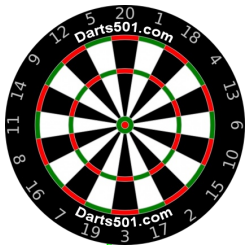Dartboard Numbers |
Why the numbers on a dartboard are arranged the way they are is a question that is frequently asked question.

The number system on the board is often credited to Brian Gamlin, a carpenter from Bury, Lancashire. He is said to have invented it at the age of 44 in 1896, but he died in 1903 without patenting. But after extensive research viewing the English and Wales Census and contacting Bury Newspapers and archives, no trace of Brian existence can be found. It is not to say he didn't exist, as some reports say that Brian was also attached to a travelling circus and may have missed the census at the time!
According to another source, Thomas William Buckle invented the modern dartboard in 1913. The source in question is his son, Thomas Edward Buckle, who 1992 made this statement in Darts World (issue 234).
The numbering system on a standard dartboard (London Clock / Yorkshire Dartsbord) is designed in such a way as to reduce 'lucky shots' and reduce the element of chance. The numbers are placed to encourage accuracy and punish inaccuracy. The placing of low scoring numbers either side of large numbers, e.g. 1 and 5 either side of 20, 3 and 2 either side of 17, 4 and 1 either side of 18, will punish poor throwing. If you shoot for the 20 segment, the penalty for lack of accuracy is to land in either a number 1 or a 5. That is it.
Article produced for 'Darts World ' & 'We Love Darts' Magazines by David King
Brian Gamlin is thought to have lived in Bury Lancashire during the late 19th century and at the age of 44, produced the devious dartboard numbering system into the fairgrounds we see today boasting 'No skill required'. Drunks' had no chance, as the odd segments were a test of sobriety, the darts game 'round the clock', in which players have to score with darts in numerical order, became a great success. However, Gamlin remains to this day an enigma.
Darts Historian Dr Patrick Chaplin, along with other interested historians has tried to track down birth and death records of Brian Gamlin without successes. Dr Chaplin also has written to many people with the surname of Gamlin in Bury, Lancashire and Bury St Edmunds, Suffolk in the hope of retracing ancestors of Gamlin without success.
The Bury Times newspaper featured an article on the 13th October 2005, and a further entry on the 27th October 2005 to find any ancestors tp Gamlin, this however also drew a blank.
In the newly published book 'Darts in England 1900 – 1939: A social history Dr Chaplin records that Dave Lanning (Sky Sports darts commentator) originally revealed this 'fact' in 1979 from information he had culled from the Daily Mirror cuttings library during his research for his ghosted biographical work on the late Welsh darts professional Leighton Rees. The Daily Mirror published details about Gamlin from a reader in Germany after a reader responded to their article 'Who decided the numbers on a dartboard should be so jumbled and why?'
Gamlin has gone down in history based on this response, and until now hasn't been able to traced. Gamlin was thought to be a travelling man, very possibly a showman, and thus may never be found. Indeed this story may live on without the 'truth' every being known.
But people in Bury, Lancashire may also wish to know that, according to Dr Chaplin there are two other people who lay claim invention of the modern dartboard numbering system. The first being E. Walkers, a wire worker from Leeds. However, the most likely candidate is Thomas Buckle, a wire-worker from Dewsbury, Yorkshire, who is said to have devised the dartboard from a 'Five's dartboard' a twelve-segment board which he made into a more complex twenty-segment dartboard. Buckles' dartboard became known as the 'Yorkshire board' and was later adapted in the south by the addition of the treble ring and outer bullseye to become known as the 'London or London Clock dartboard'.
Bury's council's flower display 'A tribute to Brian Gamlin' again begs the questions did this man ever exist? and does Bury have a claim to the invention of the modern dartboard numbering system?"
If proof cannot be found soon that a son of Bury, Lancashire invented the modern dartboard, then the credit will likely as not go to a Yorkshireman!
Maybe this is the last time for someone shed more light on Gamlin!